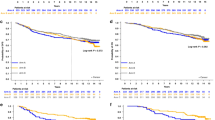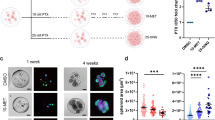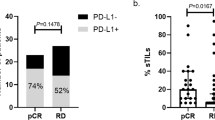Abstract
Patients with metastatic breast cancer in complete remission are the ones most likely to have an improved outcome with subsequent high-dose chemotherapy and autologous peripheral blood stem cell transplantation (HDC-PBSCT). Peripheral blood stem cells are usually procured following mobilization with single agent chemotherapy and colony-stimulating factor support. We utilized a dose-intense regimen of paclitaxel 200 mg/m2 i.v., etoposide 60 mg/kg i.v., and cyclophosphamide 3 g/m2 i.v. (TEC) followed by daily administration of granulocyte colony-stimulating factor. The aim was not only to mobilize stem cells but also to achieve optimal tumor cytoreduction prior to HDC/PBSCT. One hundred consecutive patients with metastatic breast cancer received 257 cycles of TEC between March 1994 and June 1997, with the aim of collecting 5 × 106 CD34-positive cells/kg usually following the second cycle of chemotherapy. Patient characteristics included a median age of 45 years, a median of two organ systems involved by disease, a median of two prior chemotherapy regimens and eight prior chemotherapy cycles, and a median interval of 8 months from diagnosis of metastases to first cycle of TEC. There were 61 febrile episodes during neutropenia and 13 of these were associated with bacteremia or fungemia. Mortality rate was 1%. An adequate number of stem cells was collected in 90% of patients. The overall response rate of the tumor was 58.8% with 23.7% complete responders among 97 evaluable patients. Multivariate analysis demonstrated chemosensitivity to the most recent standard chemotherapy regimen administered for metastatic disease, an ECOG performance score of 0 as opposed to 1, 2 or 3, and involvement by disease of only one organ system as significant variables for achieving a complete remission with TEC. This novel dose-intense regimen was safe and well tolerated, highly active against metastatic breast cancer, and capable of excellent stem cell mobilization. Bone Marrow Transplantation (2000) 25, 123–130.
This is a preview of subscription content, access via your institution
Access options
Subscribe to this journal
Receive 12 print issues and online access
$259.00 per year
only $21.58 per issue
Buy this article
- Purchase on SpringerLink
- Instant access to full article PDF
Prices may be subject to local taxes which are calculated during checkout
Similar content being viewed by others
References
Bezwoda WR, Seymour L, Dansey RD . High-dose chemotherapy with hematopoietic rescue as primary treatment for metastatic breast cancer: a randomized trial J Clin Oncol 1995 13: 2483–2489
Stadtmauer EA, O'Neill A, Goldstein LJ et al. Phase III randomized trial of high dose chemotherapy (HDC) and stem cell support (SCT) shows no difference in overall survival or severe toxicity compared to maintenance chemotherapy with cyclophosphamide, methotrexate and 5-fluorouracil (CMF) for women with metastatic breast cancer who are responding to conventional induction chemotherapy: the Philadelphia Intergroup Study (PBT-1) Proc Am Soc Clin Oncol 1999 18: 1a
Antman KH, Rowlings PA, Vaughan WP et al. High-dose chemotherapy with autologous hematopoietic stem-cell support for breast cancer in North America J Clin Oncol 1997 15: 1870–1879
Siena S, Bregni M, Belli N et al. Flow cytometry for clinical estimation of circulating hematopoietic progenitors for autologous transplantation in cancer patients Blood 1991 77: 400–409
Gregory CJ, Eaves AC . Human marrow cells capable of erythropoietic differentiation in vitro: definition of three eythroid colony responses Blood 1977 49: 855–864
Miller AB, Hoogstraten B, Staguet M, Winkler A . Reporting results of cancer treatment Cancer 1981 47: 207–214
McCredie K, Hersh E, Friereich E . Cells capable of colony formation in the peripheral blood of man Science 1971 171: 293–294
Richman CM, Weiner RS, Yankee RA . Increase in circulating stem cells following chemotherapy in man Blood 1976 47: 1031–1039
To LB, Haylock DN, Kimber RJ, Juttner CA . High levels of circulating hemopoietic stem cells in very early remission from acute non-lymphoblastic leukemia and their collection and preservation Br J Haematol 1984 58: 399–410
Henon PR, Butturini A, Gale RP . Blood-derived hematoipoietic cell transplants: blood to blood? Lancet 1991 337: 961–963
Lowry PA, Tabbara IA . Peripheral hematopoietic stem cell transplantation: current concepts Exp Hematol 1992 20: 937–942
Gillespie TW, Hillyer CD . Peripheral blood progenitor cells for marrow reconstitution: mobilization and collectionstrategies Transfusion 1996 36: 611–624
To LB, Haylock DN, Simmons PJ, Juttner CA . The biology and clinical uses of blood stem cells Blood 1997 89: 2233–2258
Moog R, Muller N . Technical aspects and performance in collecting peripheral blood progenitor cells Ann Hematol 1998 77: 143–147
Siena S, Bregni M, Brando M et al. Circulating CD34+ hematopoietic stem cells in the peripheral blood of high-dose cyclophosphamide-treated patients: enhancement by intravenous recombinant human granulocyte–macrophage colony-stimulating factor Blood 1989 74: 1905–1914
To LB, Shepperd KM, Haylock DN et al. Single high doses of cyclophosphamide enable the collection of high numbers of hemopoietic stem cells from the peripheral blood Exp Hematol 1990 18: 442–447
Tarella C, Ferrero D, Bregni M et al. Peripheral blood expansion of early progenitor cells after high-dose cyclophosphamide and rhGM-CSF Eur J Cancer 1991 27: 22–27
Demirer T, Buckner CD, Storer B et al. Effect of different chemotherapy regimens on peripheral-blood stem-cell collections in patients with breast cancer receiving granulocyte colony-stimulating factor J Clin Oncol 1997 15: 684–690
Demirer T, Rowley S . Buckner CD et al. Peripheral-blood stem-cell collections after paclitaxel, cyclophosphamide, and recombinant human granulocyte colony-stimulating factor in patients with breast and ovarian cancer J Clin Oncol 1995 13: 1714–1719
Socinski MA, Cannistra SA, Elias A et al. Granulocyte–macrophage colony stimulating factor expands the circulating hemopoietic progenitor cell compartment in man Lancet 1988 I: 1194–1198
Haas R, Ho AD, Bredthauer U et al. Successful autologous transplantation of blood stem cells mobilized with recombinant human granulocyte–macrophage colony stimulating factor Exp Hematol 1990 18: 94–98
Sheridan WP, Begley CG, Juttner CA et al. Effect ofperipheral-blood progenitor cells mobilized by filgrastim(G-CSF) on platelet recovery after high-dose chemotherapy Lancet 1992 339: 640–644
Peters WP, Rosner G, Ross M et al. Comparative effects of granulocyte–macrophage colony-stimulating factor (GM-CSF) and granulocyte colony-stimulating factor (G-CSF) on priming peripheral blood progenitor cells for use with autologous bone marrow after high-dose chemotherapy Blood 1993 81: 1709–1719
Rosenfeld CS, Shadduck PK, Zeigler ZR et al. Cyclophosphamide mobilized peripheral blood stem cells in patients with lymphoid malignancies Bone Marrow Transplant 1995 15: 433–438
Brugger W, Bross K, Frisch J et al. Mobilization of peripheral blood progenitor cells by sequential administration of interleukin-3 and granulocyte–macrophage colony-stimulating factor following polychemotherapy with etoposide, ifosfamide, and cisplatin Blood 1992 79: 1193–1200
Schneider JG, Crown JP, Wasserheit C et al. Factors affecting the mobilization of primitive and committed hematopoietic progenitors into the peripheral blood of cancer patients Bone Marrow Transplant 1994 14: 877–884
Schimazaki C, Oku N, Ashihara E et al. Collection of peripheral blood stem cells mobilized by high-dose Ara-C plus VP-16 or aclarubicin followed by recominant human granulocyte-colony stimulating factor Bone Marrow Transplant 1992 10: 341–346
Menichella G, Pierelli L, Scambia G et al. Low-dose cyclophosphamide in combination with cisplatin or epirubicin plus rhG-CSF allows adequate collection of PBSC for autotransplantation during adjuvant therapy for high-risk cancer Bone Marrow Transplant 1994 14: 907–912
Weaver CH, Schwartzberg LS, Birch R et al. Collection of peripheral blood progenitor cells after the administration of cyclophosphamide, etoposide, and granulocyte-colony-stimulating factor: an analysis of 497 patients Transfusion 1997 37: 896–903
Schwartzberg LS, Weaver CH, Birch R et al. A randomized trial of two doses of cyclophosphamide with etoposide and G-CSF for mobilization of peripheral blood stem cells in 318 patients with stage II–III breast cancer J Hematother 1998 7: 141–150
Steward DA, Guo D, Morris D et al. Superior autologous blood stem cell mobilization from dose-intensive cyclophosphamide, etoposide, cisplatin plus G-CSF than from less intensive chemotherapy regimens Bone Marrow Transplant 1999 23: 111–117
Bensinger W, Appelbaum F, Rowley S et al. Factors that influence collection and engraftment of autologous peripheral-blood stem cells J Clin Oncol 1995 13: 2547–2555
Weaver CH, Hazelton B, Birch R et al. An analysis of engraftment kinetics as a function of the CD34 content of peripheral blood progenitor cell collections in 692 patients after the administration of myeloblative chemotherapy Blood 1995 86: 3961–3969
Olivieri A, Offidani M, Ciniero L et al. Optimization of the yield of PBSC for autotransplantation mobilized by high-dose chemotherapy and G-CSF: proposal for a mathematical model Bone Marrow Transplant 1994 14: 273–278
Bensinger WI, Longin K, Appelbaum F et al. Peripheral blood stem cells (PBSCs) collected after recombinant granulocyte colony stimulating factor (rhG-CSF): an analysis of factors correlating with the tempo of engraftment after transplantation Br J Haematol 1994 87: 825–831
Elias AD, Ayash L, Anderson KC et al. Mobilization of peripheral blood progenitor cells by chemotherapy and granulocyte–macrophage colony-stimulating factor for hematologic support after high-dose intensification for breast cancer Blood 1992 79: 3036–3044
Kohno A, Takeyama K, Narabayashi M et al. Low-dose granulocyte colony-stimulating factor enables the efficient collection of peripheral blood stem cells after disease-oriented, conventional-dose chemotherapy for breast cancer, malignant lymphoma and germ cell tumor Bone Marrow Transplant 1995 15: 49–54
Harris JR, Morrow M, Norton L . Malignant tumors of the breast. In: DeVita VT Jr, Hellman S, Rosenberg SA (eds) Cancer. Principles and Practice of Oncology Lippincott-Raven: Philadelphia 1997 pp 1557–1616
Author information
Authors and Affiliations
Rights and permissions
About this article
Cite this article
Bilgrami, S., Feingold, J., Bona, R. et al. Dose-intense paclitaxel, etoposide and cyclophosphamide: a safe and active regimen for tumor cytoreduction and stem cell mobilization in metastatic breast cancer. Bone Marrow Transplant 25, 123–130 (2000). https://doi.org/10.1038/sj.bmt.1702125
Received:
Accepted:
Published:
Issue date:
DOI: https://doi.org/10.1038/sj.bmt.1702125
Keywords
This article is cited by
-
Dose intensity in anthracycline-based chemotherapy for metastatic breast cancer: mature results of the randomised clinical trial ANZ 9311
Breast Cancer Research and Treatment (2019)
-
Dexamethasone, paclitaxel, etoposide, cyclophosphamide (d-TEC) and G-CSF for stem cell mobilisation in multiple myeloma
Bone Marrow Transplantation (2001)



